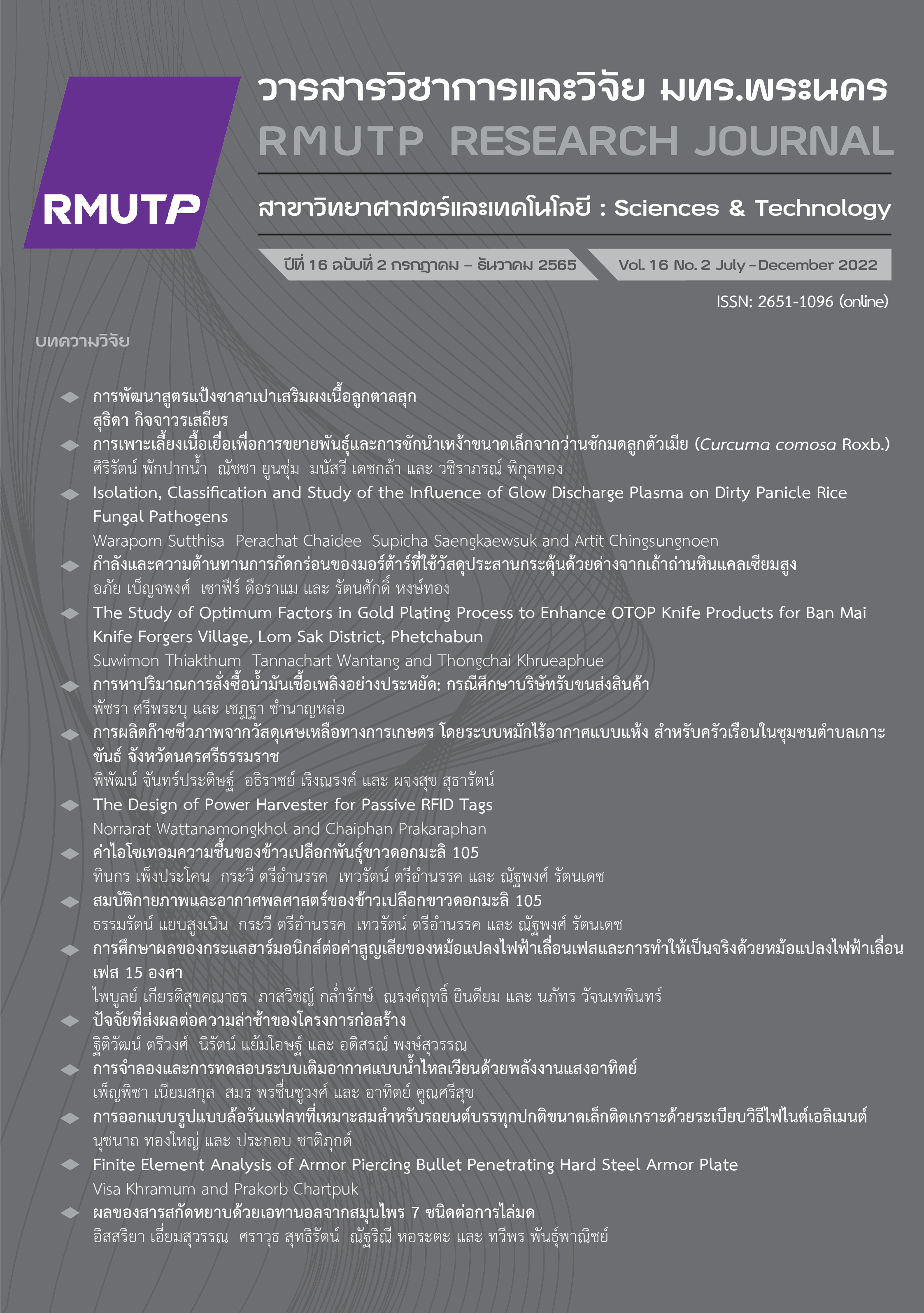Strength and Acid Resistance of Mortar Made from Alkali Activated High Calcium Fly Ash
Main Article Content
Abstract
The aim of this study is developed of alkali activated high calcium fly ash to use as cementitious material to replace Portland cement. The mixture of mortar made from fly ash and sodium hydroxide solution (NaOH) was used to activate strength at concentrations of 2, 4, 6 and 8 molars. Superplasticizer was used to control the flow of mortar in the rage of 105 – 110. The compressive strength of mortar was determined at 7, 28, 45 and 60 days. The acid resistance of mortars due to sulfuric at a concentration of 3% were also investigated. The results showed the mortar made from high calcium fly ash with sodium hydroxide of 6 molar obtained the highest compressive strength, which could be developed compressive strength up to 189 ksc at 60 days.
For the acid resistance of mortar, it was found that the of use 6 molar of NaOH activated high calcium fly ash binder had the least weight loss due to sulfuric acid attack.
Article Details

This work is licensed under a Creative Commons Attribution-NonCommercial-NoDerivatives 4.0 International License.
ลิขสิทธ์ ของมหาวิทยาลัยเทคโนโลยีราชมงคลพระนครReferences
M. J. Nadoushan and A. A. Ramezanianpour, “The effect of type and concentration of activators on flowability and compressive strength of natural pozzolan and slag-based geopolymers,” Construction and Building Materials, vol. 111, pp. 337–347, May 2016.
M. Najimi and N. Ghafoori, “Engineering properties of natural pozzolan/slag based alkali-activated concrete,” Construction and Building Materials, vol. 208, pp. 46–62, May 2019.
F. Puertas, S. Martıńez-Ramıŕez, S. Alonso and T. Vazquez, “Alkali-activated flyash/slag cements: Strength behaviour and hydration products,” Cement and Concrete Research, vol. 30, no. 10, pp. 1625–1632, Oct. 2000.
P.K. Mehta, “Global concrete industry sustainability,” Concrete International, vol. 31, no. 2 pp. 45–48, 2009.
A. Fernández-Jiménez and A. Palomo, “Characterisation of fly ashes. Potential reactivity as alkaline cements,” Fuel, vol. 82, no. 18, pp. 2259–2265, Dec. 2003.
T. Bakharev, “Resistance of geopolymer materials to acid attack,” Cement and concrete research, vol. 35, no. 4, pp. 658–670, Apr. 2005.
ASTM C109, “Standard Test Method for Compressive Strength of Hydraulic Cement Mortars (Using 2-in. or [50 mm] Cube Specimens),” American Society for Testing and Materials, 2017.
ASTM C618, “Standard Specification for Coal Fly Ash and Raw or Calcined Natural Pozzolan for Use in Concrete,” American Society for Testing and Materials, 2017.
N. Makul and B. Chatveera, “Properties of Fly Ash-based Geopolymer Mortar: Influence of Fly Ash Sources and Sodium Silicate (Na2SiO3) / Sodium Hydroxide (NaOH) Ratios,” KMUTT Research and Development Journal, vol. 36, no. 1, pp. 99–124, Jan.–Mar. 2013.
E. Gomaa, S. Sargon, C. Kashosi and M. ElGawady, “Fresh properties and compressive strength of high calcium alkali activated fly ash mortar,” Journal of King Saud University-Engineering Sciences, vol. 29, no. 4, pp. 356–364, Oct. 2017.
F. Winnefeld, A. Leemann, M. Lucuk, P. Svoboda and M. Neuroth, “Assessment of phase formation in alkali activated low and high calcium fly ashes in building materials,” Construction and building materials, vol. 24, no. 6, pp. 1086–1093, Jun. 2010.
S. Dueramae, W. Tangchirapat, P. Chindaprasirt and C. Jaturapitakkul, “Influence of activation methods on strength and chloride resistance of concrete using calcium carbide residue–fly ash mixture as a new binder,” Journal of Materials in Civil Engineering, vol. 29,
no. 4, p. 04016265, Apr. 2017.
S. Hanjitsuwan, B. Injorhor, T. Phoo-ngernkham, N. Damrongwiriyanupap, L.Y. Li, P. Sukontasukkul and P. Chindaprasirt, “Drying shrinkage, strength and microstructure of alkali-activated high-calcium fly ash using FGD-gypsum and dolomite as expansive additive,” Cement and Concrete Composites, vol. 114, p. 103760, Nov. 2020.
M. Eiamwijit, K. Pachana, S. Kaewpirom, U. Rattanasak and P. Chindaprasirt, “Comparative study on morphology of ground sub-bituminus FBC fly ash geopolymeric material,” Advanced Powder Technology, vol. 26, pp. 1053–1057, Apr. 2015.
Y. Rifaai, A. Yahia, A. Mostafa, S. Aggoun and E.H. Kadri, “Rheology of fly ash - based geopolymer: Effect of NaOH concentration,” Construction and Building Materials, vol. 223, pp. 583–594, Oct. 2019.
Sindhunata, J. L. Provis, G.C. Lukey, H. Xu and J.S. van Deventer, “Structural evolution of fly ash based geopolymers in alkaline environments,” Industrial & engineering chemistry research, vol. 47, no. 9, pp. 2991–2999, May 2008.
S. Sasui, G. Kim, J. Nam, A. van Riessen and M. Hadzima-Nyarko, “Effects of waste glass as a sand replacement on the strength and durability of fly ash/GGBS based alkali activated mortar,” Ceramics International, vol. 47, no. 15, pp. 21175–21196, Aug. 2021.
C. Eakpanich, “A Study of Sulfuric Acid Attack on Mortar Containing Pozzolan,” M.S. thesis, Dept. Civil Eng., King Mongkut”s University of Technology Thonburi, Bangkok, Thailand, 2003.


